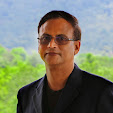Who doesn’t like melody? Whose heart doesn’t beat for Kishore Kumar’s yodeling? Whose ears don’t reverberate with Lata Mangeshkar’s eternal songs? Who doesn’t want to dance with Asha Bhosle’s scintillating numbers? Music is already in every heartbeat and yet in the humdrum and cacophony of hundreds of singers and thousands of albums among us, we still tend to miss the true music in its more intense and sublime melody. We seem to be content with the tip of the iceberg which floats on top of the water but that is only one tenth of the real content. Our fleeting lives just get spent listening to few repeated singers over and over again, be it Kishore Da of sixties or Udit Narayan of nineties or Sonu Nigam of 21st century. We never transcend the popular songs such as, Mere sapno ki rani (Aradhna), Papa kehte hain bada (QSQT), Mehdi laga ke rakhna (DDLJ), and of course, the recent hits from Veer Zaara, Lagaan, Chalte Chalte, Kal Ho Na Ho…..the list is endless. But, you get the point. We have virtually surrounded ourselves with popular film music and that seems to work for us. To some more ambitious folks, this boundary also encompasses few popular ghazals of Jagjit Singh, Pankaj Udhas and in rare cases some Bhajans of Anup Jalota.
To be sure, there is no need to advocate any boundary between popular and classical music. This dichotomy unnecessarily creates boundaries between melodies. Instead, all that is needed is to explore, experiment and expand our boundaries of melodies. If we have been listening mainly to Kishore Kumar, let us now try to immerse ourselves into Mohammad Rafi and see how this new musical wave refreshes us all over again. If we are already listening to Rafi Sahab, let’s get an album in which he has sung songs which are closer to a classical raga. Again, not to be frightened or overwhelmed with the word “classical”, but the idea is to expose ourselves to little different and melodious mood of music. There are actually several albums available in music stores and of course on internet websites which have collection of classical songs of several singers. As I am typing this, I have just now started playing Begum Akhtar’s album with her songs based on some classical ragas. This is the first time in my life that I am listening to her. I may not appreciate it for the first time, but as is often the case, true melody always “grows in” us. Even the Rahman music is often characterized in this fashion. We rarely appreciate Rahman music in our first attempt, but give it some time and something catches our attention and we fall in love with it. Who can forget, O Paalanhaare from Lagaan or some of his other songs? Simple reason that it “grows in” us is that his music has a background basis of some classical raga, either Hindustani or Karnatak style.
Similar is the case with several other songs which are based on classical ragas. We get overwhelmed with music which is shot at us from TV or Radio commercials but if we proactively discover true melody we will be surprised by what we have been missing all these years. A simple definition or criterion to judge true melody is that which is evergreen unlike a passing phase.
Let me refresh your memory with some such true gems of Manna Dey now. When was the last time you listened to poochho naa kaise maine rain bitaayee (Meri Surat Teri Aankhen), I assure you that this song can never become stale in your ears, again the simple reason is that it is based on Raga Ahir Bhairav. Similar is the case with another Manna Dey gem Laaga chunari main daag chhupaaoo kaise (Dil hi toh hai), this song is based on Raga Bhairavi. Both Bhairavi and Ahir Bhairav are morning ragas so as you listen to these two numbers, imagine yourself watching sun rise and you will be amazed by the power of these ragas, they actually take you to the time of dawn! While, we are on the topic of morning ragas, let me throw in another masterpiece from Lata Mangeshkar. This is a song from the film Amar Prem, Raina biti jaye shyam na aaye and is based on another pre-dawn raga called Raga Lalit. Once again, be prepared to be fascinated by the power of music and melody. And who can forget Mohe bhul gaye sanvariya in Lataji’s voice from the film Baiju Bawara. Again, reason for its eternal appeal is that it is based on Raga Bhairav. Another gem from this film in Rafi Sahab’s voice based on Raga Bhairavi is Tu gangaki mauj main jamna ka dhaara. These are just a few gems based on morning ragas.
Now, let’s see some masterpieces from afternoon raga. Khiltey Hain Gul Yaha (Sharmilee)and Panthi hoon main us path kaa (Door ka rahi) both based on Raga Bhimpalasi, sung by Kishore Kumar. And now the evening ragas. Again, while you listen to these songs, imagine watching a sunset somewhere on a small hill. How about Umraav Jaan’s ghazal sung by Ashaji in ankhonki mastike mastane hazaron hai, based on Raga Bhupali. Even if you have never heard of Mehdi Hassan’s ghazals, try these two of his most popular ones, both based on evening ragas. Ranjish hee sahi (Raga Yaman) and Duniya kisike pyaar main (Raga Bhupali). I am convinced that if you develop the taste for Mehdi Sahab’s ghazals, you may never fall back to any other singer who is not classically trained. It would be a quantum leap from a narrow well into a vast and deep ocean of music in which you will be beckoned by such great titans as Bhimsen Joshi, Pt Jasraj and so on. Obviously, this takes little investment of time and patience. But, from my own experience, I guarantee you that it is worth the effort and the returns are priceless and lifelong. It is indeed a nashaa, with traces of meditative spiritual mood.
Now, let’s move little more forward in our time of the day towards night. Two of the more popular ragas of this time of the day are Raga Malkauns and Raga Darbari. To start with, fall in love all over again with Rafi Sahab’s eternal voice in Man tarpat hari darshanko aaj (Baiju Bawara) based on Raga Malkauns. How about these Raga Darbari numbers Hangama hai kyon barpa, a Ghulam Ali ghazal and O Duniyake rakhwale (Baiju Bawara) by Rafi Sahab. Even Mukesh has sung a Raga Darbari song, Dil jalta hai to jalne de (Pahli Nazar). And who can forget mere naina saavan bhaado (Mehbooba) by Kishore Da and Lataji which was based on Raga Shivranjani, another night raga. Again, try imagining yourself in nightly mood to enjoy these songs better. As is the case with serious and true melodies, most of the songs based on ragas either have matching lyrics with the words of that time of the day or a mood matching with that of raga. Morning ragas are usually identified with intense mood of separation and of meditation. Evening ragas evoke lighter mood of love and romance. Night ragas evoke the moods of passion and heroic courage. You can find hundreds of songs and the classical ragas that they are based on at http://www.asavari.org/songs.html. Listening and appreciating music armed with the information of raga would relish both your heart and your mind.
I recently had heated debate with few friends whose argument was that a criterion for good music is simply what appeals to masses. According to them, “classical” singers do not have enough popularity or prestige. Also that, only that music is great which survives the test of “market value”. One can respond to such criticism by just stating few examples from above masterpieces. Granted that some great artists end up in a life of paucity but how can that be a judge of true music? Gangotri, the origin of Ganga, can never be compared with small streams in every village or town. A true explorer will reach the Gangotri sooner or later even though every stream is also a reflection of the same river. Idea is just to expand, explore, experiment and finally to experience yourself to different genres of music and to appreciate the entire iceberg instead of just being content with its tip afloat.
Some say, “don’t sell yourself short”; I think we can apply this to our topic. Let’s not settle for mediocre music, let’s try to explore and expand our musical horizons. And the good news is many different kinds of music are now available on several good websites. www.Raaga.com and www.MusicIndiaOnline.com are two excellent sources. I would even go one step further and say that the way T-Series liberated old film songs from the clutches of HMV with hundreds of cover version pirated tapes; internet is doing the same to rare genres of music. If not for online albums, I would have never experienced the heavenly voice of Mehdi Hassan. Now, I know why he can be called as the “Everest”, the highest point of ghazal singing. So, unlike pirated tapes, we have original music now available to us, all that is needed is little effort from our side and then we will be ready for….
Sangeet Hai Shakti Ishwar Ki, Har Swar Main Base Hain Raam
Raagi Jo Sunaye Raagini, Rogi Ko Mile Aaraam.
References:
1. Alaap, a set of 20 CDs exploring Indian Classical Music produced by Sri Aurobindo Society http://www.sriaurobindosociety.org.in/saspub/sasaudvis.htm#audiocds
2. http://www.AIMArts.org
3. http://www.MusicIndiaOnline.com
4. http://www.Raaga.com
5. http://www.Asavari.org
6. http://www.MusicalNirvana.com
Teaching and researching religions, languages, literatures, films, and ecology of India: http://philosophy.unt.edu/people/faculty/pankaj-jain
Dr. Pankaj Jain
Subscribe to:
Post Comments (Atom)
Facebook Badge
FEEDJIT Live Traffic Map
पंकज जॆन








1 comment:
hi, pankajaindia.blogspot.com!
[url=http://viagradeb.fora.pl/] viagra bestellen online[/url] [url=http://viagradea.fora.pl/] viagra bestellen [/url] [url=http://viagradec.fora.pl/] viagra kaufen ohne rezept[/url] [url=http://viagraded.fora.pl/] viagra [/url] [url=http://viagradef.fora.pl/] viagra bestellen ohne rezept[/url] [url=http://viagradee.fora.pl/] viagra ohne rezept[/url]
Post a Comment